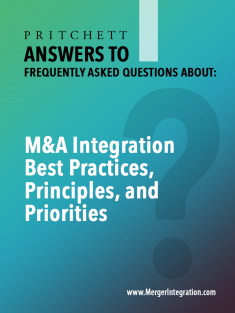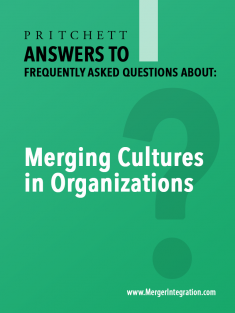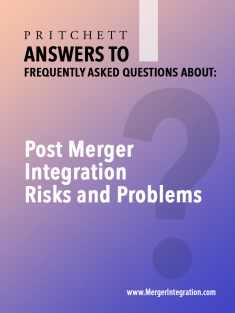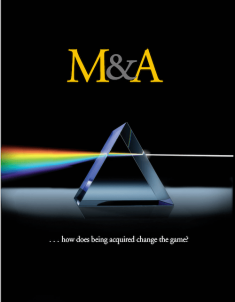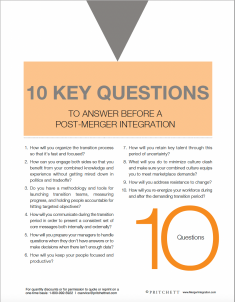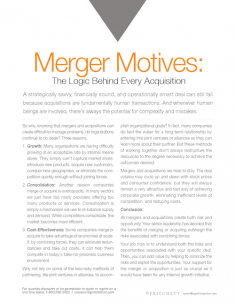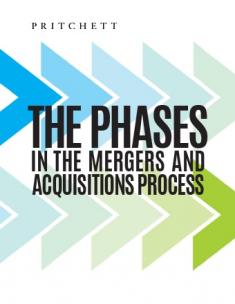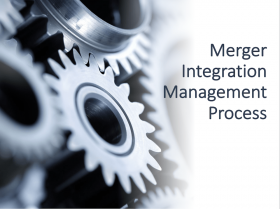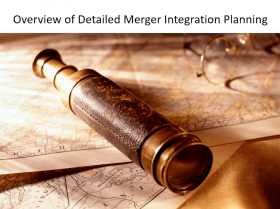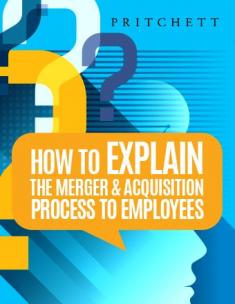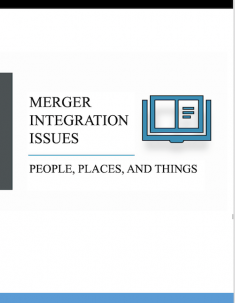Answers to FAQs about M&A Integration

What Every Acquirer Should Know about Post-Merger Integration
Answers to these questions:
- Why should acquirers follow a well-defined process for an M&A integration?
- What is the single best predictor of M&A integration success?
- What is the most consequential meeting in an M&A integration?
- What is usually the worst managed aspect of integrations?
- What is the usual length of an M&A integration?
- Why are early wins critical to M&A success?
- Why should staffing decisions be made early?
- What are the most common complaints from employees during an integration?
- What is an M&A integration playbook?
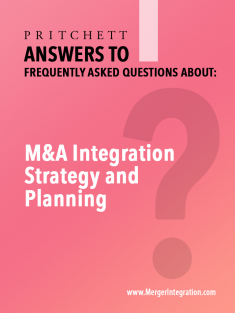
M&A Integration Strategy and Planning
Answers to these questions:
- What are the five types of integration strategies?
- When should the M&A integration planning process start?
- What is the first step in integration planning?
- What are the key elements in an M&A integration plan?
- What is a post-merger integration end state?
- What is a 100-Day Plan?
- What should executive not say when announcing the deal to employees?
- Why is Day 1 so important?
- To what extent should acquirers integrate?
- Is it more difficult to integrate a “merger of equals” than other types of mergers?
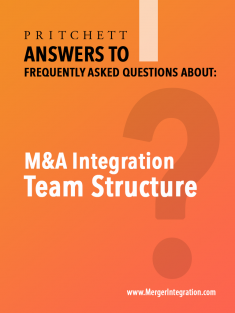
M&A Integration Team Structure
Answers to these questions:
- What is the typical team structure for an M&A integration?
- What is integration governance?
- Who is on the integration steering committee and what is its role?
- What is an Integration Management Office (IMO)?
- What is the role of the Integration Manager?
- What are the seven key attributes an Integration Manager should have?
- How much time should integration team members dedicate to an integration?
- When should you invite the target to participate in planning?
- What is an M&A integration team charter?
- When should M&A integration teams be disbanded?
M&A Integration Assessment
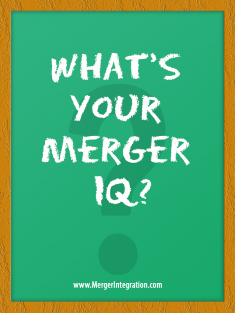
What's Your Merger IQ?
Companies often struggle through integrations because managers have been taught little about the process or, even worse, have been taught the wrong things. Many of the correct moves are not obvious.
Learn what you really know about merger management. Take our 16-question online Merger IQ exam. The answers to the test are based on PRITCHETT LP's three decades of acquisition integration consulting experience.
M&A Integration Articles
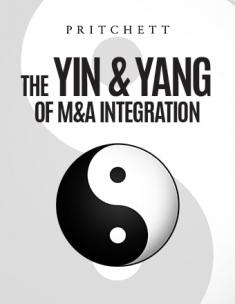
The Yin and Yang of M&A Integration
The yin-yang symbol represents the ancient Chinese understanding of how things work. In the context of merger integration, think of the white area (yang) as the “hard stuff” and the black area (yin) as the “soft stuff.” Yang is project management, yin is people management. So which do you think is more important?
Too often, merging organizations concentrate too heavily on one at the expense of the other. Both project and people management require adequate attention in order to realize the full potential of an acquisition.
PRITCHETT’s Merger Integration Certification Workshop does not take a piecemeal approach. It covers both the yin and yang.
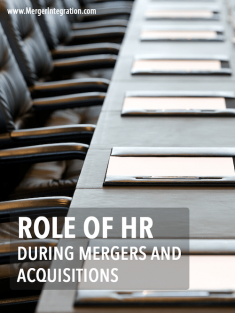
Role of HR During Mergers and Acquisitions
Three things that are guaranteed to give HR a better seat at the table:
- Preemptively prepare for M&A. Anticipate. Provide in-depth training for HR staff on the fundamentals of due diligence, merger integration strategy, how to reconcile culture differences, etc. Ensure that the HR Team is very sophisticated on merger dynamics and positioned to serve as a merger-savvy resource to people in other functions.
- Rethink HR's conventional wisdom on how success should be measured. HR is the guardian of workforce issues such as morale, trust, job satisfaction, stress levels, and employee loyalty, but those metrics will take wicked turns for the worse during a merger. Success is better measured by tracking productivity, quality, market share, customer satisfaction, and– above all– profitability. This is highly counterintuitive for HR people, but these are the critical markers for the integration process...
Post-Merger Integration Process
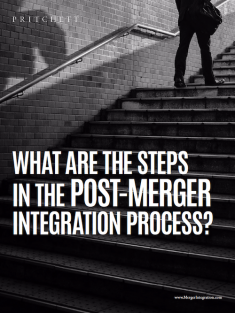
What are the Steps in the Post-Merger Integration Process?
The 11 steps to follow when integrating two organizations:
- Define Integration Strategy and Guiding Principles
Facilitate executive session with senior leaders to determine planning direction and clarify integration goals, assumptions, non-negotiables, success metrics, and vision.
- Determine M&A Integration Governance
Define the hierarchy, structure, roles, and resources for the integration project.
- Conduct Integration Management Office (IMO) Meeting
Plan and facilitate an IMO kickoff event to formally commence the integration process and officially onboard integration teams by reviewing pre-planning input, rules of engagement, objectives, and methodology.

